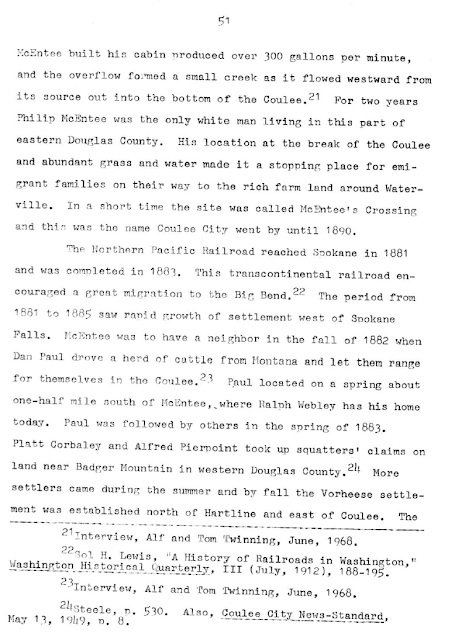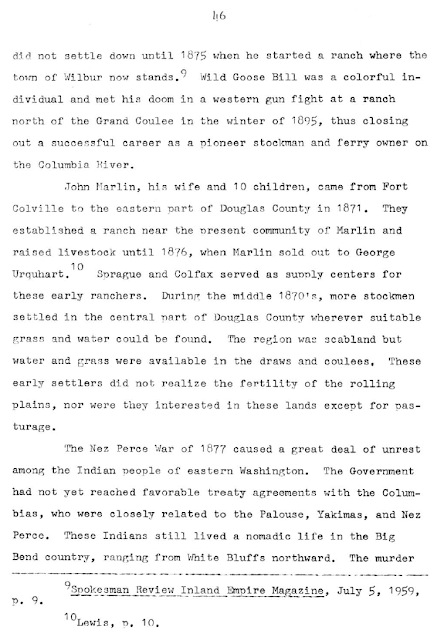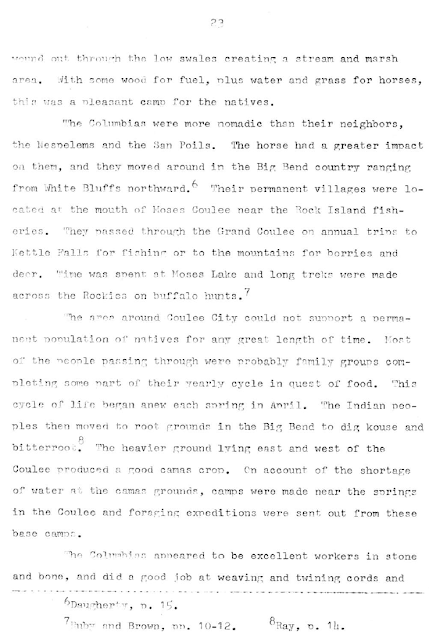________________________
________________________
50
Settlement at the Middle Crossing of the Coulee
After the Indian scare of 1878-1879 had subsided, settlement increased in the Big Bend. Philip McEntee came to Washington as a member of the international boundary surveying party in 1877. He saved his money and upon completion of the survey, he invested in cattle and located where Coulee City now stands. 19 In 1881 he built a cabin just east of the present high school, near the big artesian spring that for many years supplied most of the water for the town. Philip McEntee was described as an energetic Scotsman with an iron will. Steel has this to say about this man:
In the early days when this portion of the state (then a territory) was uninhabited except by Indians and an occasional white man, Mr. McEntee would start from where Coulee City now stands with a band of cattle, drive them across several hundred miles of unbroken wilderness away up into British Columbia, where he would sell them, together with his pack horse and make the return journey on foot swimming rivers, sleeping on the snow covered ground with only a blanket to protect him from the inclemency of the weather, and no companion within a hundred miles. 20While there was no great farming area close by, McEntee's claim was ideally located at the middle crossing of the Coulee. The springs that bubbled to the surface made the spot "a veritable Oasis in the Scab Rock." The spring near the place where
____________
19 Steele, p. 523.
20 Ibid.
________________________
51
McEntee built his cabin produced over 300 gallons per minute, and the overflow formed a small creek as it flowed westward from its source out into the bottom of the Coulee. 21 For two years Philip McEntee was the only white man living in this part of eastern Douglas County. His location at the break of the Coulee and abundant grass and water made it a stopping place for emigrant families on their way to the rich farm land around Waterville. In a short time the site was called McEntee's Crossing and this was the name Coulee City went by until 1890.
The Northern Pacific Railroad reached Spokane in 1891 and was completed in 1883. this transcontinental railroad encouraged a great migration to the Big Bend. 22 The period from 1881 to 1885 saw rapid growth of settlement west of Spokane Falls. McEntee was to have a neighbor in the fall of 1882 when Dan Paul drove a herd of cattle from Montana and let them range for themselves in the Coulee. 23 Paul located on a spring about one-half mile south of McEntee, where Ralph Webley has his home today. Paul was followed by others in the spring of 1883. Platt Corbaley and Alfred Pierpoint took up squatters' claims on land near Badger Mountain in western Douglas County. 24 More settlers came during the summer and by fall the Vorheese settlement was established north of Hartline and east of the Coulee.
____________
21 Interview, Alf and Tom Twining, June, 1968.
22 Sol H. Lewis, "A History of Railroads in Washington," Washington Historical Quarterly, III (July, 1912), 188-195.
23 Interview, Alf and Tom Twining, June, 1968.
24 Steele, p. 530. Also, Coulee City News-Standard, May 13, 1949, p. 8.
________________________
52-53
.
Fig. 10. -- Homesteader's Cabins
Alfred Pierpoint built this cabin on a homestead claim south of Waterville in the spring of 1883. He moved to the Highland area about 10 miles west of Coulee City some time after 1884
This is the cabin that Phil McEntee built at Coulee City in 1881. It was located east of the present high school on property now owned by Everett Rice.
________________________
54
The prospects of growth were evident when the Territorial Legislature created Lincoln and Douglas Counties in November of 1883. The estimated population of Douglas County at that time was 100 to 150 persons. 25
At the crossing of the Coulee, McEntee and Paul were joined by John Lewis and Dan Twining, Welsh immigrants, who located in the Coulee just north of the present town. Lewis sowed 10 acres of wheat on experimental basis, and after cutting the grain, he stacked it and built a corral. Using a band of Cayuses he tromped the grain from the straw and used the wind to fan it. 26 At this point it is interesting to note that the first four settlers at McEntee's Crossing came from a variety of national backgrounds. McEntee was a Scotchman, Paul an Irishman, and Lewis and Twinning were Welshmen. Lewis was very active in the next few years providing information about the area to newspapers in his native Wales to encourage other Welshmen to settle at McEntee's Crossing. The Welsh were to constitute the largest single nationality group in the early years of settlement.
In 1886, the northern half of the Columbia Indian Reservation was opened for mineral prospecting. 27 The evidence of mineral wealth became known in 1859, but the region had been closed to white settlement. The prospects of lode deposits resulted in a second rush of miners across the Big Bend from Ellensburg, Sprague, and Spokane in the spring of 1886.
____________
25 Steele, p. 531.
26 Ibid., p. 535
27 Louis, p. 4.
________________________
55
Mining activity was started in the vicinity of Loomis, Conconully, and Ruby. The town of Ruby grew to 3,000 people in a short time. 28 These scattered mining communities were almost entirely dependent upon pack trains and freight wagons for their supplies, most of which were brought from the railhead at Sprague. By 1888, regular stage lines and freight lines were in operation and Condin had a ferry on the Columbia River. 29 Steamboats were in operation up the Columbia from Rock Island to the Okanogan by July of 1888, thus helping Ellensburg to participate in the trade. 30
The prospects of being on a supply route to the mines brought more settlers and businessmen into the Big Bend. The transportation facilities in use, stage and freight lines, needed a supply of horses and mules. This promoted more stock raising. The winter of 1880-81 had hurt the open range cattle business, but herds were building up again in spite of the prairie fire in June of 1883, which burned the grass off the land east of the Coulee to Almira. 31
The assessment rolls of Douglas County taken in 1885 showed a total of 239 residents, 8,250 acres of land, with a total valuation of $20,445.50 for the land and $920 for improvements. Personal property was valued at $117,332.80, most of which was livestock. McEntee and Paul paid taxes at this time totaling $111.02 and $$71.25, respectively. 32
____________
28 Ibid., p. 4-6.
29 Virginia R. Beck, "Columbia River Ferries," Okanogan County Heritage, IV (September, 1966), 25-29.
30 Robert E. Long, "Steamboating on the Upper Columbia River 1888-1915" (unpublished Masters thesis, Washington State College, 1950), pp. 18-19.
31 Steele, p. 529
32 Ibid., pp. 536-537
________________________
56
After the creation of Douglas County in 1886, there was a struggle for the county seat between the settlers east and west of the Coulee. The western part had the greater population and they won out in an election, but they could not decide between Waterville and Okanogan. Another election was required before Waterville was selected as the center of county government. 33
The years of 1886, 1887, and 1888 saw substantial growth in the population of the county. A number of new business concerns developed in the summer of 1888 at McEntee's Crossing. George R. Roberts opened a general merchandise store one-half mile north of the present main street where the city park is located today. Mail was going through from Ritzville to Waterville and Roberts became the first postmaster of McEntee. In the fall, a second store and blacksmith shop was started by Levi Salmon. Dan Twining opened a saloon. 34 The increased mining activity to the north and the prospects of a railroad were drawing more people to the area. In 1889, the population of Douglas County was 2,651, of which 276 were living in the Grand Coulee. 35
____________
33 Ibid., p. 541. Okanogan was a small settlement that existed near Waterville at this time.
34 Ibid., pp. 558-559.
35 Ibid., p. 547.
________________________
57-58
Fig. 11. -- Early Home Sites
Philip McEntee built a cabin at this location in 1891. Before 1900 he had constructed the house in the middle picture at the same site. The spring that supplies much of the domestic water needs of the town is located in the grove of trees in the background.
This is the house that Philip McEntee built prior to his death in 1901. It was built on his original homestead, but since has been moved to the west side of town and is currently being used as a barn.
Dan Paul settled at this spring south of town in 1882. This location is at the head of one of the scabland coulees that eroded the floor of the Grand Coulee proper.
________________________
________________________






































